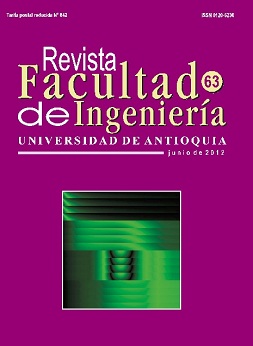Evaluación de la QoS en redes HFC para la distribución de aplicaciones de televisión digital interactiva (TDI)
DOI:
https://doi.org/10.17533/udea.redin.12480Palabras clave:
T-Learning, HFC, DOCSIS, QoS, Televisión Digital interactiva (TDi)Resumen
Las aplicaciones desarrolladas para Televisión Digital interactiva (TDi) consumen recursos adicionales en las redes de telecomunicaciones. Es por tanto necesario realizar un análisis y evaluación de los protocolos y recursos de la red de telecomunicaciones utilizados para asegurar el correcto funcionamiento de este tipo de aplicaciones, cuando entren a competir con otros servicios que se distribuyen simultáneamente. Este artículo presenta un análisis y evaluación de los parámetros de desempeño de la red Hibrida de Fibra y Coaxial (HFC, Hybrid Fiber Coaxial), cuando aplicaciones de T-Learning comparten los recursos de red con otros servicios tales como HTTP, FTP y VoIP. Para ello, se propone un modelo de simulación en el que se analiza el throughput, la pérdida de paquetes, el retardo y el jitter en la red HFC ante diferentes configuraciones de los parámetros que ofrece el protocolo de especificación de la interfaz de servicios de datos sobre cable (DOCSIS, Data Over Cable Service Interface Specification) para brindar mejor Calidad de Servicio (QoS, Quality of Service).Descargas
Citas
J. Arciniegas, J. Amaya, F. Urbano, W. Campo, R. Euscategui, A. García, X. García. “EDiTV: Educación Virtual Basado en Televisión Interactiva para Soportar Programas a Distancia”. Revista de ciencia, educación, innovación y cultura apoyadas por redes de tecnología avanzada. Vol. 1. 2011. pp. 42-47.
Proyecto ST-CAV: Servicios de T-Learning para Soportar una Comunidad Académica Virtual. Disponible en: http://www.unicauca.edu.co/stcav. Consultado el 1 de agosto de 2011.
P. Aarreniemi, J. Tuominen. Experiences with an interactive learning environment in digital TV. Proceedings of the IEEE International Conference on Advanced Learning Technologies. Washington, Estados Unidos. 2004. pp. 296-300.
A. Smith, S. Morris. Interactive TV Standards: A Guide to MHP, OCAP and JavaTV. Ed. Focal Press - Elsevier. Estados Unidos. 2005. pp. 1-611.
Cable Labs. Data-Over-Cable Service Interface Specification, DOCSIS 1.1, Radio Frequency Interface Specification. Ed. Cable Labs. Estados Unidos. 2005. pp. 1-436.
W. Campo, D. Rueda, I. Taimal, J. Arciniegas. “Análisis del protocolo DOCSIS para la distribución de aplicaciones y contenidos de TDi en la red HFC”. Revista Avances en Sistemas e Informática. Vol. 6. 2009. pp. 119-132.
W. Campo, G. Chanchí, F. Urbano, J. Arciniegas. Recomendaciones para el despliegue de contenidos de T-Learning. XI Congreso Internacional de Interacción Persona Ordenador. España. 2010. pp. 119-128.
R. García, V. García, X. Pañeda, D. Melendi. “Analysis and modelling of a broadband fiber access network with high peer-to-peer traffic load”. Simulation Modelling Practice and Theory. Vol. 14. 2006. pp. 506-526. DOI: https://doi.org/10.1016/j.simpat.2005.09.001
D. Melendi, R. García, X. Pañeda, V. García. “Modelling and simulation of a real Internet radio service”. Journal of Simulation. Vol. 5. 2010. pp. 111- 122. DOI: https://doi.org/10.1057/jos.2010.11
OPNET Technologies. Specialized Models User Guide. Ed. Cisco Systems. Estados Unidos. 2005. pp. 1-246.
D. Rueda, W. Campo, I. Taimal, J. Arciniegas. Caracterización de la distribución de contenidos de TDi en el canal interactivo de la red HFC. V Congreso Iberoméricano de Telemática – CITA 2009. Gijón, España. 2009. pp. 193-196.
R. García. Desarrollo de un modelo de red con tecnología FTTX para transmisión de voz y datos, análisis del protocolo de acceso al medio y validación del tráfico generado. Tesis Doctoral. Área de Ingeniería Telemática. Universidad de Oviedo. Gijón, España. 2005. pp. 1-313.
ITU-T. ITU-T Recommendation G.1010: End-user multimedia QoS categories. Ed. ITU-T. Suiza. 2001. pp. 1-18.
Descargas
Publicado
Cómo citar
Número
Sección
Licencia
Derechos de autor 2018 Revista Facultad de Ingeniería

Esta obra está bajo una licencia internacional Creative Commons Atribución-NoComercial-CompartirIgual 4.0.
Los artículos disponibles en la Revista Facultad de Ingeniería, Universidad de Antioquia están bajo la licencia Creative Commons Attribution BY-NC-SA 4.0.
Eres libre de:
Compartir — copiar y redistribuir el material en cualquier medio o formato
Adaptar : remezclar, transformar y construir sobre el material.
Bajo los siguientes términos:
Reconocimiento : debe otorgar el crédito correspondiente , proporcionar un enlace a la licencia e indicar si se realizaron cambios . Puede hacerlo de cualquier manera razonable, pero no de ninguna manera que sugiera que el licenciante lo respalda a usted o su uso.
No comercial : no puede utilizar el material con fines comerciales .
Compartir igual : si remezcla, transforma o construye a partir del material, debe distribuir sus contribuciones bajo la misma licencia que el original.
El material publicado por la revista puede ser distribuido, copiado y exhibido por terceros si se dan los respectivos créditos a la revista, sin ningún costo. No se puede obtener ningún beneficio comercial y las obras derivadas tienen que estar bajo los mismos términos de licencia que el trabajo original.










 Twitter
Twitter